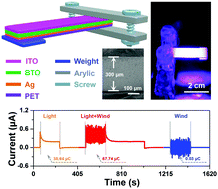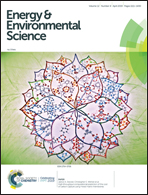Piezo–pyro–photoelectric effects induced coupling enhancement of charge quantity in BaTiO3 materials for simultaneously scavenging light and vibration energies†
Abstract
Ferroelectrics have attracted great attention due to their above-bandgap photovoltages. To improve the quantum efficiency and fill factor of ferroelectric photovoltaic devices, recent studies have focused on band and electrode engineering. Here, we report the enhancement of charge quantity in ferroelectric BaTiO3 materials by coupling piezo–pyro–photoelectric effects. The influencing factors for photovoltaic performance and the interaction of various effects in BaTiO3 were investigated under various working conditions. The observed modulation of ferroelectric photovoltaic performance is directly related to the piezoelectric constant of BaTiO3, which can increase on decreasing the device temperature. By simultaneous application of vibration and wind, a temperature decrease of the device is observed, resulting in the best charging performance. A 4.7 μF capacitor can be easily charged to 0.44 V in 20 s. This work pushes forward a significant step toward the modulation of ferroelectric photovoltaic performance, which holds great promise for intelligent energy generation from the ambient environment and potential applications in self-powered micro/nano-devices.



 Please wait while we load your content...
Please wait while we load your content...